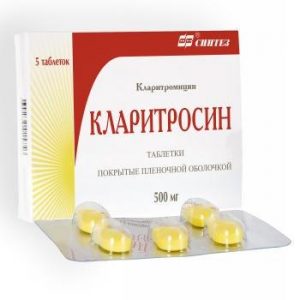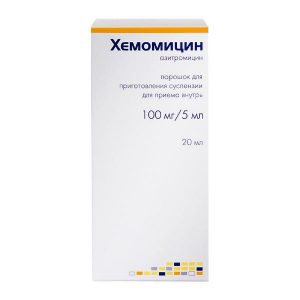Description
Release form
Tablets.
Packing
10 pcs.
Pharmacological action
Pharmacodynamics
Antibiotic from the macrolide group.
The mechanism of antibacterial action is due to inhibition of protein synthesis in the microbial cell due to binding to the 50S subunit of the ribosome.
Commonly susceptible microorganisms (BMD 1 mg / L): Streptococcus. Staphylococci sensitive to methicillin. Enterococci. Rhodococcus equi. Bacillus cereus. Branhamella catarrhalis. Bordetella pertussis. Helicobacter pylori. Campylobacter spp. Legionella spp. Corynebacterium diphtheriae. Moraxella spp. Mycoplasma pneumoniae. Coxiella spp. Chlamydia spp. Treponema pallidum. Borrelia burgdorferi. Leptospira spp. Propionibacterium acnes. Actinomyces spp. Eubacterium spp. Porphyromonas spp. Mobiluncus spp. Bacteroides spp. Peptostreptococcus spp. Prevotella spp. Toxoplasma gondii.
Moderately susceptible microorganisms: Neisseria gonorrhoeae. Ureaplasma urealyticum. Clostridium perfringens. In relation to these pathogens, the antibiotic is moderately active in vitro, positive results can be observed with antibiotic concentrations in the focus of inflammation higher than BMD.
Resistant microorganisms (MIC> 4 mg / L), at least 50% of the strains are resistant: Methicillin-resistant staphylococci. Enterobacter spp. Pseudomonas spp. Acinetobacter spp. Nocardia asteroides. Fusobacterium spp. Haemophilus spp. Mycoplasma hominis. Corynebacterium jekeium.
Spiramycin penetrates and accumulates in phagocytes (neutrophils, monocytes and peritoneal and alveolar macrobiophages). In humans, the concentration of the drug inside the phagocytes is quite high. These properties explain the effects of spiramycin on intracellular bacteria.
Pharmacokinetics
Absorption
Absorption of spiramycin occurs quickly, but incompletely, with great variability (from 10% to 60%). After taking Rovamycin orally at a dose of 6 million IU C max, spiramycin in plasma is about 3.3 μg / ml.
Distribution of
Spiramycin penetrates and accumulates in phagocytes (neutrophils, monocytes and peritoneal and alveolar macrophages). In humans, the concentration of the drug inside the phagocytes is quite high. This explains the effectiveness of spiramycin against intracellular bacteria.
Spiramycin does not penetrate into the cerebrospinal fluid excreted in breast milk. Penetrates through the placental barrier (the concentration in the blood of the fetus is approximately 50% of the concentration in the blood serum of the mother). Concentrations in placental tissue are 5 times higher than the corresponding concentrations in serum.
V d approx. 383 l The drug penetrates well into saliva and tissues (concentration in the lungs is 20-60 μg / g, in tonsils – 20-80 μg / g, in infected sinuses – 75-110 μg / g, in bones – 5-100 μg / g) . 10 days after the end of treatment, the concentration of spiramycin in the spleen, liver, and kidneys is 5-7 μg / g. Plasma protein binding is low (approximately 10%).
Metabolism and excretion
Spiramycin is metabolized in the liver to form active metabolites with an unknown chemical structure.
It is excreted mainly with bile (concentration is 15-40 times higher than in serum). Renal excretion of active spiramycin is about 10% of the administered dose. T 1/2 after ingestion of 3 million IU of spiramycin inside is approximately 8 hours.
Pharmacokinetics in special clinical cases
T 1/2 lengthens in the elderly. In patients with impaired renal function, dosage adjustment is not required.
Indications
Infectious and inflammatory diseases caused by drug-sensitive microorganisms: ENT infections: sinusitis tonsillitis
infections of the lower respiratory tract (including acute community-acquired pneumonia, including SARS, exacerbation of chronic bronchitis) infections of the skin and soft tissues: erysipelas, secondary infected dermatoses, impetigo, ectima, erythrasma
infection of bones and joints
infection of the reproductive system (non-chronic etiology)
toxoplasmosis, incl. in pregnant
, prophylaxis of meningococcal meningitis in cases where rifampicin is contraindicated: eradication of Neisseria meningitidis in the nasopharynx of spiramycin is not used to treat meningococcal meningitis. The drug is recommended for prevention in patients after treatment, as well as in people who had contact with the patient 10 days before his hospitalization
prophylaxis of acute articular rheumatism in people with an allergic reaction to penicillins.
Contraindications
Lactation period
glucose-6-phosphate dehydrogenase deficiency (risk of acute hemolysis)
children under 18 years of age
hypersensitivity to spiramycin and other components of the drug.
Caution: for obstruction of the bile ducts of liver failure.
Use during pregnancy and lactation
Rovamycin may be used during pregnancy if indicated.
When prescribing Rovamycin during lactation, breast-feeding should be discontinued, since spiramycin with breast milk may be excreted.
Spiramycin did not show teratogenic effects.
A decrease in the risk of transmitting toxoplasmosis to the fetus during pregnancy is noted from 25% to 8% when using the drug in the first trimester, from 54% to 19% in the second trimester and from 65% to 44% in the third trimester.
Special instructions
In patients with impaired liver function, liver function indicators should be monitored during the period of use of the drug.
Caution is advised to use the drug with ergot alkaloids.
Use in cases of impaired liver function
Rovamycin is prescribed with caution in case of obstruction of the bile ducts or in liver failure.
Use for impaired renal function
Patients with impaired renal function due to small renal excretion of spiramycin do not need to change the dose.
Composition
1 tablet contains:
Active substances: spiramycin – 3 million IU.
Excipients: colloidal silicon dioxide, magnesium stearate, pregelatinized corn starch, hydroxypropyl cellulose (hyprolose), croscarmellose sodium (sodium carboxymethyl cellulose), microcrystalline cellulose.
Shell composition: titanium dioxide, macrogol 6000, hypromellose.
Dosage and administration of
Adults are prescribed 2-3 tablets of 3 million IU (i.e. 6-9 million IU) per day for 2 or 3 doses. The maximum daily dose is 9 million IU.
For the prevention of meningococcal meningitis
For the prevention of meningococcal meningitis, adults are prescribed a drug of 3 million IU 2 times / day (6 million IU / day) for 5 days.
Use in patients with impaired renal function
Patients with impaired renal function due to small renal excretion of spiramycin do not need to change the dose.
Side effects of the digestive system: nausea, vomiting, diarrhea are very rare (less than 0.01%) – pseudomembranous colitis, changes in liver function tests and the development of cholestatic hepatitis in isolated cases – ulcerative esophagitis and acute colitis. The possibility of developing acute damage to the intestinal mucosa in patients with AIDS with the use of spiramycin in high doses for cryptosporidiosis (only 2 cases) was also noted.
From the side of the central nervous system and peripheral nervous system: transient paresthesia.
From the hemopoietic system: very rarely (less than 0.01%) – acute hemolysis and thrombocytopenia.
From the cardiovascular system: prolongation of the QT interval on the ECG is possible.
Allergic reactions: skin rash, urticaria, skin itching very rarely (less than 0.01%) – angioedema, anaphylactic shock.
Local reactions: rarely – mild irritation along the vein, which only in exceptional cases may require discontinuation of treatment.
Other: in some cases, vasculitis, including Shenlein-Genoch purpura.
Drug Interactions
With simultaneous use with drugs containing a combination of levodopa and carbidopa, a decrease in plasma levodopa levels was observed (clinical monitoring and some change in levodopa dose are necessary).
overdose Symptoms: Spiramycin overdose is unknown. Possible symptoms are nausea, vomiting, diarrhea.
Treatment: Symptomatic therapy is carried out if necessary. There is no specific antidote.
Storage conditions
Store in a dry place at a temperature not exceeding 25 ° C.
Keep out of the reach and sight of children.
Shelf life
4 years.
Deystvuyushtee substance
Spiramycin
Terms and conditions
prescription
dosage form
tablets
Indications
Indications
Bronchitis, Urinary tract infections, Sinusitis, Vaginal infections, Skin infections, Pneumonia, Pharyngitis
Sanofi-Aventis, France




